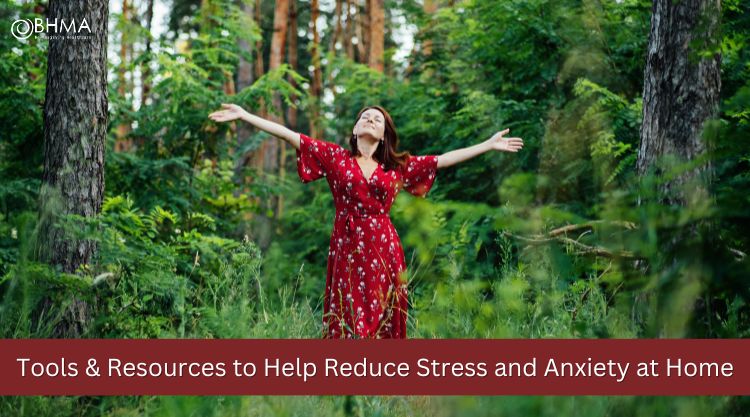Tools & Resources to Help Reduce Stress and Anxiety at Home
Sophie Bishop, Medical and Health Writer
The modern world is very stressful. Unfortunately, our stress responses are ancient. Our bodies and brains respond to an upcoming exam the same way they’d respond to a charging woolly mammoth – and that’s not helpful!
Hopefully evolution will eventually catch up with society and future generations will easily be able to handle things like coursework stress and existential angst. But until then, we need to work with what we’ve got.
So, we need to coach up and coming generations in how to handle their stress levels.
Here are some simple tips which can help you to help teens deal with stress:
1. Encourage healthy eating habits
It’s boring, we know, but there is a correlation between lifestyle, diet, and mental health. A healthy, balanced diet will improve your physical health. This in turn impacts your mental health.
The brain is reliant on the body. By feeding your body healthy nutrients, you also feed your brain. You can boost your mood and beat back stress through something as simple as improving your eating habits.
This is especially true with teens, whose growing brains will always benefit from a healthy diet. But there’s a caveat: When discussing diet with teens, it’s important to focus on healthy eating habits rather than on a specific diet.
Modern relationships with food are complicated. With the growth of social media, the link between what we eat, how we look, and who we are has become increasingly complicated and disordered. So, it’s important to focus on eating habits rather than specific things like calories or nutrients.
The aim is to help them develop a healthy relationship with food, not to inadvertently make them obsess about what they’re eating.
2. Promote exercise
The link between physical and mental health is evident. It’s worth equipping yourself with as much information and expert resources when it comes to tackling anxiety in teenagers. However, consistent exercise can help relieve some of that additional stress and anxiety your child might be feeling.
You don’t have to drag your teen to the gym to give them the stress-busting benefits of exercise. Taking them for a quick walk around the block will also work wonders.
When we work out, our bodies produce endorphins. Endorphins are neurotransmitters designed to make us feel good. Endorphins alone can be a quick solution to anxiety.
But wait! There’s more! Exercise can tackle stress on an evolutionary level.
See, the stress response evolved to help us escape from threats. The ‘stress hormone’, cortisol, sends glucose flooding through your blood to your muscles, raises your heart rate, and pumps your brain full of sugars.
The short-term effect of all this is very useful in a fight-or-flight situation. If you have to flee from a predator or fight for your life, you need to think and act extremely fast. So, if you’re ever faced with an angry saber-toothed tiger, cortisol is your friend.
The problem is that modern stressors aren’t (usually!) the kinds of immediate threat that the stress response was designed for. Rather than saber-toothed tigers, modern threats are things like exams, climate crisis, bad bosses, and domestic drama. Things you can’t (or, rather, shouldn’t!) literally fight your way out of.
So, you end up with cortisol and its effects swirling around in your body for far, far longer than it’s supposed to. That’s why, when you’re stressed, you get a racing heart and churning thoughts – your body is trying to do something with its stress response, but it’s hurting you in the attempt.
Where does exercise come into this? Well, exercise (literally) burns through cortisol in the way your body expects it to. Through exercise, you can work off those raised blood sugars and bring your racing thoughts back under control.
The best part is, you don’t even need to do much exercise. A quick stroll can boost your endorphins and trick your body into burning through cortisol.
How can you encourage a teen to exercise? Well, if you’re a teacher, something as simple as asking them to run an errand could do the trick. If a teen is spiraling, sending them on a walk through the corridors to another teacher’s office with a sealed envelope could work wonders. They don’t need to know what’s in the envelope (maybe a note saying ‘This student needed a walk’). The important thing is that they get out of the classroom and get moving.
3. Explore the outdoors
Studies consistently show that getting outside is incredible for anxiety. Being outdoors seems to have a calming, soothing effect on the human mind.
Why? Well, science isn’t exactly sure. Scientists know that getting outside works, but there are lots of competing theories as to why. The truth is probably a combination of all of them:
- Being outside often involves exercise, like walking. See above for more on how exercise helps to beat stress!
- Being outside stimulates our senses in the way they were designed for. Your brain is comforted by things like feeling the wind on your face, hearing sounds like running water, seeing greenery, and so on. What’s more, this gentle sensory stimulation can break focus on racing thoughts.
- Being outside takes us away from the environment that stresses us out..
- Being outside gives you time and space to reflect and gain perspective.
Green spaces are especially good for this, so if you are lucky enough to have access to green spaces then take time to explore them with your teen. But if you don’t, don’t worry. Even urban outdoor environments can work wonders.
4. Bring it back to the senses
If you feel yourself spiraling into a vicious cycle of intrusive thoughts, it’s important to break your focus on those thoughts.
Easier said than done, we know! But often the simplest methods of distraction are the best. Exercise, going for a walk, taking a breath of fresh air – all of these things can pull your brain back to where it needs to be.
But what about when you’re a teen, stuck at a school desk or in a flat with no realistic escape?
Teens can still use their immediate surroundings to help them out of stress spirals. Try teaching them the 5,4,3,2,1 method.
Encourage stressed teens to focus on:
- 5 things they can see. For example, their hands, the sky, the floor, a tree, a person.
- 4 things they can feel. Whatever they’re holding, the ground under their feet, the sun on their face.
- 3 things they can hear. Breath, typing sounds, writing sounds, birdsong…
- 2 things they can smell. Fresh air, coffee, laundry detergent…
- 1 thing they can taste. Chewing gum, the air, a glass of water….
5. Take a nap
We live in a culture that claims napping is lazy. Honestly, that’s rubbish. Humans didn’t evolve to work and sleep in 8 hour blocks. Our natural circadian rhythms are way more complicated than that.
In fact, it’s very natural for humans to nap. For most of human history, people around the world took a nap at some point in the afternoon. For example, the Ancient Greeks and Romans built an early afternoon nap into their cultures (the word ‘siesta’ comes from the Latin ‘sexta hora’ – ‘sixth hour’, which was when people traditionally took a nap).
Even in cold northern countries where daylight is precious, napping used to be very normal. Until the 18th century, British people routinely had ‘two sleeps’ (one in the late afternoon and another in the late evening).
All in all, the nap-free day is a very modern invention, brought on by the 9-5 work day model. And teen mental health may be suffering from it.
Rather than insisting that a tired, grumpy, stressed teen knuckles down and powers through, encouraging them to take a quick ‘power nap’ could work wonders. It will break their focus on intrusive thoughts and give their body a chance to break down all that disruptive cortisol.
Help teens to help themselves
Stress management strategies are, unfortunately, something we all need these days. One of the very best things you can do for a modern teen is to give them quick, easy stress-management strategies that they can take forward with them into adult life.


